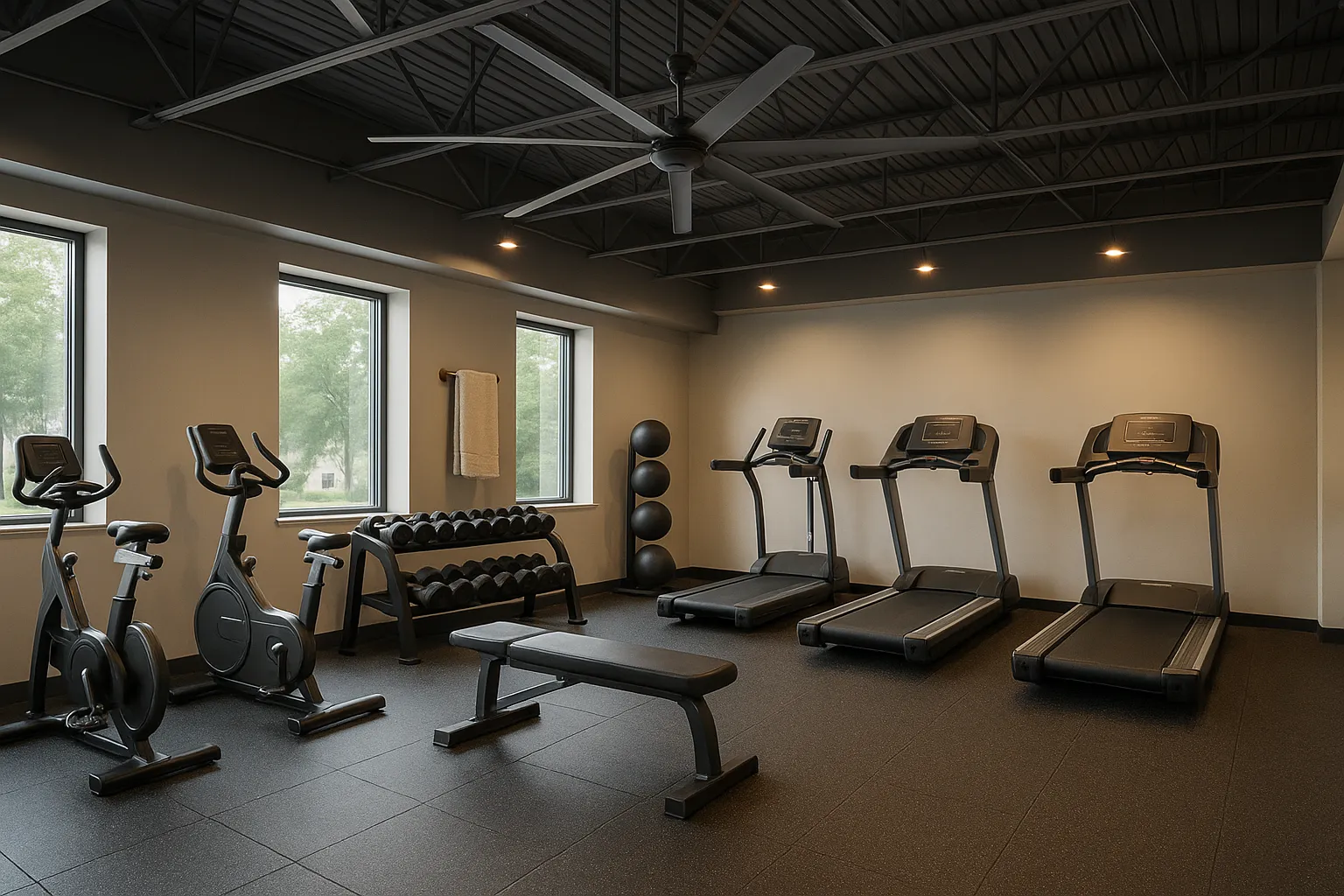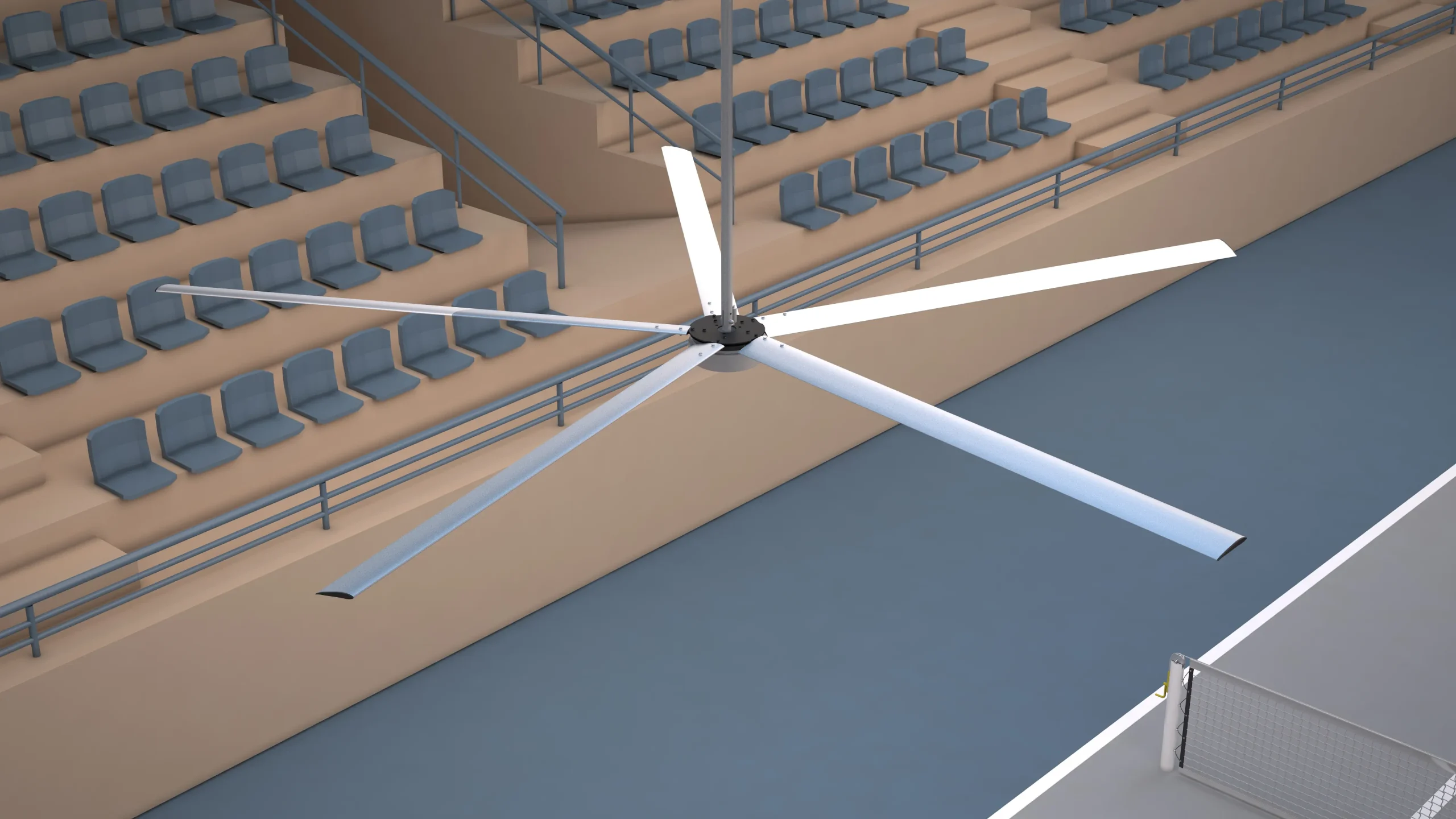Sweltering summers, frigid winters, and stagnant air sabotage comfort in warehouses, gyms, and factories. Uneven temperatures inflate energy bills and drain morale. Ventilateurs de plafond HVLS wipe out these uncomfortable conditions—gently balancing heat layers, cutting costs, and elevating productivity.
Big industrial ceiling fans—high‑volume, low‑speed (HVLS) fans—move massive amounts of air at gentle speeds. Stretching up to 24 ft, one fan balances hot and cold layers across 20 000 sq ft, trimming HVAC runtimes 20–40 % and delivering uniform comfort in industrial and commercial spaces.
Before diving into specs, let’s clarify why the industriel et commercial world calls these giants “HVLS.”
High‑Volume, Low‑Speed (HVLS) units rotate at just 50–90 RPM, yet their heavy‑duty aluminum or composite pales de ventilateur stretch 8–24 ft. That scale produces a wide, slow-moving column of air that spreads evenly before rising up walls—creating a continuous convection loop.
“One single HVLS fan can replace up to 20 traditional ventilateur de sol ou drum fan units, freeing precious floor space and slashing maintenance.” — Field Test, Midwest HVAC Consultants
Quick comparison: The table below summarizes the essential design contrasts.
| Design Element | Ventilateur HVLS | Traditionnel ventilateur commercial |
|---|---|---|
| Blade span | 8–24 ft | 2–5 ft |
| Vitesse | < 90 RPM | > 300 RPM |
| Coverage per unit | Up to 20 000 sq ft | 400–600 sq ft |
| Typical noise | < 45 dB | 65 – 70 dB |
Those whisper‑quiet acoustics prove invaluable in hospitality halls and office spaces where low noise is mandatory.
Unlike box fans that blast a narrow jet, an HVLS fan produces a massive, slow “air plate” that circulates whole‑building air.
The resulting airflow pattern:
Because the loop covers ceiling‑to‑floor height, it lowers temperature and humidity extremes and discourages mold and mildew in barns, aircraft hangar bays, and distribution hubs.

hvls ceiling fan in fitness centers
To appreciate savings, you need context. The short note below sets the scene for the numbers that follow.
Intro to Table: The data compares annual electricity use before and after HVLS adoption.
| Type d'installation | Sq Ft | Pre‑HVLS kWh / yr | Post‑HVLS kWh / yr | Significant energy savings |
|---|---|---|---|---|
| Entrepôt – Phoenix | 120 000 | 870 000 | 560 000 | 36 % |
| Gym & Fitness Centers – Texas | 40 000 | 390 000 | 255 000 | 35 % |
| Aircraft Hangar – Ohio | 65 000 | 610 000 | 395 000 | 35 % |
Energy regulators count HVLS technology toward overall energy reduction credits, making the fans rebate‑eligible.
Read real‑world results on our ventilateurs hvls pour l'entrepôt page.
Selecting the right diameter isn’t guesswork; it’s about clearance, ceiling height, and desired CFM.
Rule of thumb: Tip clearance should exceed 2 ft from walls or racking to preserve laminar flow.
The chart illustrates the airflow difference between blade spans.
| Diamètre de la lame | Max CFM | Coverage (sq ft) |
|---|---|---|
| 14 ft | 85 000 | 9 000 |
| 20 ft | 168 000 | 18 000 |
| 24 ft | 210 000 | 22 000 |
“CFM” is cubic feet per minute. A 20 ft HVLS rated 168 000 CFM equals 15 pedestal fans—but draws under 1 kW.
Internal link: Explore our M650‑series hvls fans to see aerofoil options.
Facility managers often ask whether they can substitute spot coolers for HVLS units. This table spells out the trade‑offs.
| Criterion | Système de levage à grande vitesse destratification fans | Directional fans / spot coolers |
|---|---|---|
| Couverture | Whole‑building | Workstation |
| Vitesse | < 90 RPM, faible bruit | 1 000–3 000 RPM |
| Meilleur pour | Temperature balance, contrôle climatique | Intense cooling |
| Energy draw | 0.8–1.5 kW (24 ft) | 0.25 kW each × quantity |
Fan solutions often combine both: HVLS for background equilibrium, directional ventilateurs de plafond commerciaux above weld bays or ovens.
Citation
“Installing HVLS plus task fans cut our summer complaints to zero while trimming factures d'énergie 28 %.” — Facilities Manager, Ontario OEM
Proper mounting guarantees safety and performance; the bullets summarize must‑do checks.

event centers big industrial ceiling fans
Safety certifications further ensure reliability.
| Requirement | Standard |
|---|---|
| Moteur | UL‑507 or IEC 60335 |
| Vibration | ISO 14694 |
| Hub design | Lock‑tight, anti‑drop |
| Optional mist kits | IP65 rating |
Internal link: Download CAD mounts from our ventilateurs de plafond industriels pour la fabrication resource center.
Modern HVLS fans aren’t just big blades—they’re IoT devices.
Internal link: API specs live on our high volume low speed fans for commercial page.
Real‑life numbers validate the theory—here are two highlights.
Problem → 95 °F shop floor, 12 % defect spike
Solution → Four grands ventilateurs de plafond industriels (20 ft)
Result → 6 °F drop, 9 % quality gain, 14‑month ROI, comfort and productivity soared.
Problem → Heat exhaustion in athletes
Solution → Three 24 ft units plus mist option
Result → 42 % fewer incidents, concession sales up 16 %.
Internal link: Explore more on our commercial ceiling fans for sports‑centers page.
The checklist below demystifies procurement for facility managers.
Ready for a quote? Reach out via our fabricant de ventilateurs hvls page.

hvls outdoor ceiling fans
These answers tackle the queries we receive most from facility operators.
How many HVLS fans do I need for a 50 000 sq ft warehouse?
Generally two or three 20 ft units spaced 60 ft apart, adjusted for beams.
Do big ass fans® outperform other brands?
Big ass fans® sparked the category, but competitors now match specs; compare industrial grade efficiency and warranties.
Will HVLS fans curb mold in barns?
Continu mouvement de l'air dries bedding, reducing microbe growth.
Les ventilateurs HVLS sont-ils bruyants ?
At < 45 dB—library level—they beat many ventilateur de sol unités.
Do HVLS fans interfere with sprinklers?
Installed per NFPA 13—3 ft below deflectors—they remain compliant.
Can HVLS fans run with radiant heating?
Yes. Reverse mode circulates roof heat downward, boosting system efficiency.
Before the bullets, a brief recap: HVLS technology delivers cost‑effective comfort across massive footprints.
Need tailored advice? Visit the big industrial fans for manufacturing knowledge hub or schedule a free airflow audit now.

Salut, je suis Michael Danielsson, PDG de Vindus Fans, avec plus de 15 ans d'expérience dans le secteur de l'ingénierie et de la conception. Je suis ici pour partager ce que j'ai appris. Si vous avez des questions, n'hésitez pas à me contacter à tout moment. Grandissons ensemble !